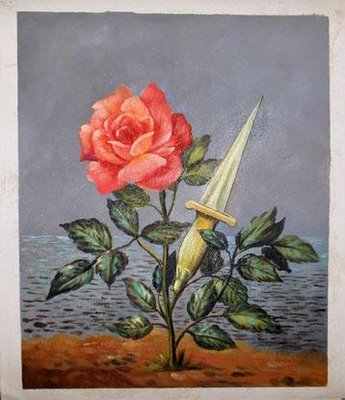Hi,
The remainder of my Magritte posts will deal with analyzing his individual paintings and murals. Le Coup au coeur is a painting of one of Magritte's icons: the rose (for another rose painting see also: Le tombeau des lutteurs- 1960). In his painting below you can see the thorns have been replaced by a sword or dagger. It's as if the beautiful flower has been transformed into a gladiator that has arrived from the sea by an invisible ship and is ready to do battle.
To me this painting is about the cruelty of woman and about Magritte's own troubled marriage and his hurt and disappointment in love. His pretty flower has a dagger and is willing to use it.

Le Coup au Coeur (The Blow to the Heart)
Title: Le Coup au coeur Oil on canvas
Description: Oil on canvas Painted in 1952. Signed Magritte (lower right); illegibly inscribed and dated Le Coup au coeur 1952 on the reverse
Dimensions: measurements 18 3/8 by 15 1/4 in. alternate measurements 46.5 by 38.7 cm
Provenance:
Ruth Moskin Gallery, New York (acquired from the artist)
Richard S. Zeisler, New York (acquired from the above circa 1955-56)
Acquired from the above by the present owner
Exhibited:
Rome, Obelisco , 1953, no. 11
Amherst College, An Exhibition of XXth Century European Painting Collected by Richard S. Zeisler , 1958, no. 16
Dallas, Museum of Contemporary Art; Houston, Museum of Fine Art, Magritte in America , 1960-61, no. 45
New York, Landry, 1961, no. 16
Minneapolis, The Walker Art Center, 1962, no. 41
London, Marlborough Gallery, Magritte , 1973, no. 67
Southampton, Long Island, The Parrish Art Museum, 1979, no. 24
New York, The Museum of Modern Art, 1981
Brussels, Musée royaux des Beaux-Arts de Belgique, Magritte , 1998, no. 174
Published:
Letter from Magritte to Iolas, October 24, 1951
Letter from Magritte to Eluard, November 27, 1951, in Manteau, 1984, pp. 66-68
Letter from Colinet to Marien, mid-December 1951, in Magritte, Destination, note to no. 238
Letter from Magritte to Iolas, April 25, 1952
Letter from Magritte to Marien, May 9, 1952, in Magritte, Destination, no. 249
Letter from Magritte to Iolas, May 19, 1952
La Carte d'après nature (Jette-Brussels), no. 1, October 1952
Letter from Magritte to Iolas, January 13, 1954
Rhétorique, September 1961, illustrated pl. 4
Robbe-Grillet, 1975, no. 90
David Sylvester, Sarah Whitfield and Michael Raeburn, René Magritte, catalogue raisonné, III: Oil Paintings, Objects and Bronzes, 1949-1967, New York and London, 1993, no. 777, illustrated p. 197
Notes:
"My present research, at the beginning of the winter, is concerned with the rose. I must find something precious and worthy to say about it" (Letter from Magritte to Iolas, October 24, 1951, quoted in David Sylvester, op. cit., p. 196) Le Coup au coeur is an iconic example of the artist's stylistic adoption of the tenets of Surrealism. A prominent figure in the Surrealist circles, Magritte was constantly exploring new directions for his art. By the time he painted this work in 1952, he had experimented briefly with Impressionist techniques after the war and now returned to the stylized realism that is so particular to his oeuvre.
The artist here explores what he found as an inherent paradox contained in a rose. In a letter which he wrote to fellow Surrealist and poet Paul Eluard, Magritte descibed the exploration that led him to the creation of Le Coup au coeur: "... for about two months I have been looking for a solution to what I call 'the problem of the rose.' My research now having been completed, I realize that I had probably known the answer to my question for a long time, but in an obscure fashion, and not only I myself but any other man likewise. This kind of knowledge, which seems to be organic and doesn't rise to the level of consciousness, was always present, at the beginning of every effort of research I made.... After completion of the research, it can be 'easily' explained that the rose is scented air, but it is also cruel, and reminds me of your 'parricidal rose.' I also recall a passage from Nougé's forbidden images: 'It is because of searing memory that we become aware of this faint scent of roses...'" (quoted in David Sylvester, op. cit., p. 197).